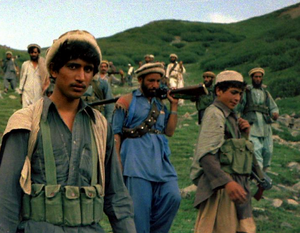NY Times:
Rival militant organizations on both sides of the Afghanistan-Pakistan border have increasingly been teaming up in deadly raids, in what military and intelligence officials say is the insurgents’ latest attempt to regain the initiative after months of withering attacks from American and allied forces.
New intelligence assessments from the region assert that insurgent factions now are setting aside their historic rivalries to behave like “a syndicate,” joining forces in ways not seen before. After one recent attack on a remote base in eastern Afghanistan, a check of the enemy dead found evidence that the fighters were from three different factions, military officials said.
In the past, these insurgent groups have been seen as sharing ideology and inspiration, but less often ideas and plans.
Now the intelligence assessments offer evidence of a worrisome new trend in which extremist commanders and their insurgent organizations are coordinating attacks and even combining their foot soldiers into patchwork patrols sent to carry out specific raids.
The change reveals the resilience and flexibility of the militant groups. But at the same time, officials say, the unusual and expanding alliances suggest that the factions are feeling new military pressure. American and NATO officials say these decisions by insurgent leaders are the result of operations from American, Afghan and allied forces on one side of the border, and from the Pakistani military — and American drone strikes — on the other.
American commanders recently have been seeking even more latitude to operate freely along the porous border, including inside Pakistan, and have consistently warned that whatever gains they have made in the past few months are fragile. One official said it was “a wake-up call” to find evidence, after the attack on the forward operating base, that the fighters were partisans from three factions with long histories of feuding: the Quetta Shura Taliban of Mullah Omar; the network commanded by the Haqqani family; and fighters loyal to the Hekmatyar clan.
These extremist groups have begun granting one another safe passage through their areas of control in Afghanistan and Pakistan, sharing new recruits and coordinating their propaganda responses to American and allied actions on the ground, officials said.
...
Colonel Seiber said insurgent commanders recognized that as the number of American forces increased this year in Afghanistan, “they would need to surge as well.” Veteran militant leaders, many with a long history of open warfare against each other, have “put aside differences when they see a common threat,” Colonel Seiber said.
Over the past 90 days, signs of this new and advanced syndication among insurgent groups have been especially evident in two provinces of eastern Afghanistan, Kunar and Paktika.
...
The new arrangement may make it easier for the US to find and destroy enemy troops. It plays into our superior fire power against massed enemy formations. It probably also aids in intelligence gathering as the groups try to communicate and coordinate with each other. If they continue to attack fortified positions it will certainly make it easier to find and destroy them.
 Image via Wikipedia
Image via Wikipedia
Comments
Post a Comment